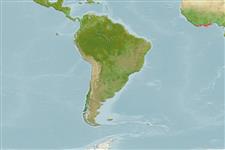Élasmobranches (requins et raies) (sharks and rays) >
Myliobatiformes (Stingrays) >
Zanobatidae (Panrays)
Etymology: maculatus: Name from Latin 'macula' for spotted; referring to its blotched colour pattern..
Environment: milieu / climate zone / depth range / distribution range
Écologie
marin démersal; profondeur 1 - 30 m (Ref. 116736). Tropical; 6°N - 5°S, 8°W - 11°E (Ref. 114953)
Distribution
Pays | Zones FAO | Écosystèmes | Occurrences | Point map | Introductions | Faunafri
Eastern Central Atlantic: Gulf of Guinea, from Ivory Coast to Gabon.
Taille / Poids / Âge
Maturity: Lm ? range ? - ? cm
Max length : 35.9 cm TL mâle / non sexé; (Ref. 116736)
Description synthétique
Clés d'identification | Morphologie | Morphométrie
This species is distinguished from its congener (Zanobatus schoenleinii) by the following combination of characters: dorsal surface of disc is brownish to reddish brown, with numerous dark brown blotches, and sometimes surrounded by a network of whitish dots; the ventral surface of disc is pale creamy white or orange-brown, with conspicuous dark brown posterolateral margins; the crown of dermal denticles of dorsal surface spearhead-shaped; dorsal surface with enlarged thorny denticles are more numerous and stronger, in parallel rows on trunk and in concentric semi-circular rows on pectoral fins; tooth rows in upper jaw 54-64 ; predorsal vertebrae 36-44 (mode 39) (Ref. 116736).
Lives mostly on sandy bottoms (Ref. 116736).
Life cycle and mating behavior
Maturities | Reproduction | Spawnings | Egg(s) | Fecundities | Larves
Séret, B., 2016. Zanobatus maculatus, a new species of panray from the Gulf of Guinea, eastern central Atlantic (Elasmobranchii: Batoidea: Zanobatidae). Zootaxa 4161(4):509-522. (Ref. 116736)
Statut dans la liste rouge de l'IUCN (Ref. 130435)
Menace pour l'homme
Harmless
Utilisations par l'homme
Outils
Articles particuliers
Télécharger en XML
Sources Internet
Estimates based on models
Phylogenetic diversity index (Ref.
82804): PD
50 = 0.7500 [Uniqueness, from 0.5 = low to 2.0 = high].
Bayesian length-weight: a=0.01000 (0.00244 - 0.04107), b=3.04 (2.81 - 3.27), in cm total length, based on all LWR estimates for this body shape (Ref.
93245).
Niveau trophique (Ref.
69278): 3.4 ±0.5 se; based on size and trophs of closest relatives
Fishing Vulnerability (Ref.
59153): Low to moderate vulnerability (26 of 100).
